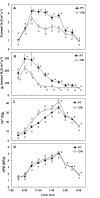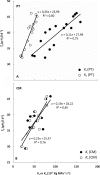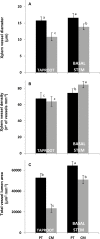An Integrated View of Whole-Tree Hydraulic Architecture. Does Stomatal or Hydraulic Conductance Determine Whole Tree Transpiration?
- PMID: 27223695
- PMCID: PMC4880183
- DOI: 10.1371/journal.pone.0155246
An Integrated View of Whole-Tree Hydraulic Architecture. Does Stomatal or Hydraulic Conductance Determine Whole Tree Transpiration?
Abstract
Hydraulic conductance exerts a strong influence on many aspects of plant physiology, namely: transpiration, CO2 assimilation, growth, productivity or stress response. However we lack full understanding of the contribution of root or shoot water transport capacity to the total water balance, something which is difficult to study in trees. Here we tested the hypothesis that whole plant hydraulic conductance modulates plant transpiration using two different seedlings of citrus rootstocks, Poncirus trifoliata (L.) Raf. and Cleopatra mandarin (Citrus reshni Hort ex Tan.). The two genotypes presented important differences in their root or shoot hydraulic conductance contribution to whole plant hydraulic conductance but, even so, water balance proved highly dependent on whole plant conductance. Further, we propose there is a possible equilibrium between root and shoot hydraulic conductance, similar to that between shoot and root biomass production, which could be related with xylem anatomy.
Conflict of interest statement
Figures









Similar articles
-
Relationships between xylem anatomy, root hydraulic conductivity, leaf/root ratio and transpiration in citrus trees on different rootstocks.Physiol Plant. 2010 Jun 1;139(2):159-69. doi: 10.1111/j.1399-3054.2010.01351.x. Epub 2010 Jan 19. Physiol Plant. 2010. PMID: 20088906
-
Water relations in tree physiology: where to from here?Tree Physiol. 2017 Jan 31;37(1):18-32. doi: 10.1093/treephys/tpw102. Tree Physiol. 2017. PMID: 28173481 Review.
-
Root signalling and modulation of stomatal closure in flooded citrus seedlings.Plant Physiol Biochem. 2011 Jun;49(6):636-45. doi: 10.1016/j.plaphy.2011.03.003. Epub 2011 Mar 12. Plant Physiol Biochem. 2011. PMID: 21459591
-
Chloride absorption in salt-sensitive Carrizo citrange and salt-tolerant Cleopatra mandarin citrus rootstocks is linked to water use.J Exp Bot. 2003 Feb;54(383):825-33. doi: 10.1093/jxb/erg064. J Exp Bot. 2003. PMID: 12554725
-
Leaf Hydraulic Architecture and Stomatal Conductance: A Functional Perspective.Plant Physiol. 2017 Aug;174(4):1996-2007. doi: 10.1104/pp.17.00303. Epub 2017 Jun 14. Plant Physiol. 2017. PMID: 28615346 Free PMC article. Review.
Cited by
-
Guard-Cell-Specific Expression of Phototropin2 C-Terminal Fragment Enhances Leaf Transpiration.Plants (Basel). 2021 Dec 26;11(1):65. doi: 10.3390/plants11010065. Plants (Basel). 2021. PMID: 35009069 Free PMC article.
-
Plasticity and the role of mass-scaling in allocation, morphology, and anatomical trait responses to above- and belowground resource limitation in cultivated sunflower (Helianthus annuus L.).Plant Direct. 2020 Oct 21;4(10):e00274. doi: 10.1002/pld3.274. eCollection 2020 Oct. Plant Direct. 2020. PMID: 33103045 Free PMC article.
-
Breeding for Climate Change Resilience: A Case Study of Loblolly Pine (Pinus taeda L.) in North America.Front Plant Sci. 2021 Apr 30;12:606908. doi: 10.3389/fpls.2021.606908. eCollection 2021. Front Plant Sci. 2021. PMID: 33995428 Free PMC article. Review.
-
Reductions in root hydraulic conductivity in response to clay soil and treated waste water are related to PIPs down-regulation in Citrus.Sci Rep. 2017 Nov 13;7(1):15429. doi: 10.1038/s41598-017-15762-2. Sci Rep. 2017. PMID: 29133958 Free PMC article.
-
Hydraulic tradeoffs underlie enhanced performance of polyploid trees under soil water deficit.Plant Physiol. 2023 Jul 3;192(3):1821-1835. doi: 10.1093/plphys/kiad204. Plant Physiol. 2023. PMID: 37002827 Free PMC article.
References
-
- Lo Gullo MA, Salleo S, Rosso R, Trifilò P. Drought resistance of 2-year-old saplings of Mediterranean forest trees in the field: relations between water relations, hydraulics and productivity. Plant Soil. 2003;250: 259–272.
-
- Mencuccini M. The ecological significance of long-distance water transport: short-term regulation, long-term acclimation and the hydraulic costs of stature across plant life forms. Plant Cell Environ. 2003;26: 163–182.
-
- Tyree M. Hydraulic limits on tree performance: transpiration, carbon gain and growth of trees. Trees. 2003;17: 95–100.
-
- Solari LI, Johnson S, DeJong TM. Hydraulic conductance characteristics of peach (Prunus persica) trees on different rootstocks are related to biomass production and distribution. Tree Physiol. 2006;26: 1343–1350. - PubMed
Publication types
MeSH terms
Substances
LinkOut - more resources
Full Text Sources
Other Literature Sources
Research Materials
Miscellaneous

